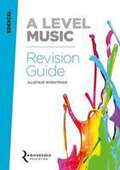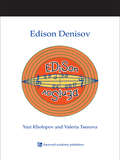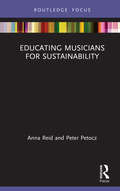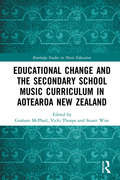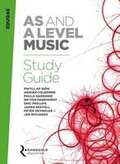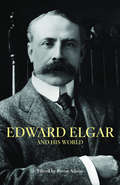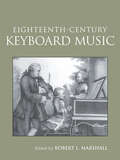- Table View
- List View
Edexcel A Level Music Revision Guide (PDF)
by Alistair WightmanThis revision guide presents all of the key information you will need to know for the written exam (Component 3 – Appraising) of the 2016 A Level specification. It includes: • The most important facts about each of the A Level set works • Extensive practice for the main essay question in the exam (Section B, essay 2), including sample answers and ‘examiner’s points’ • Top tips for preparing for the exam • A guide to the terminology you will need to know, to help you prepare for questions on the set works and ‘unfamiliar’ works
Edinburgh's Greatest Hits: A Celebration of the Capital's Music History
by Jim Byers Jonathan Trew Fiona ShepherdExplore Edinburgh's hidden music heritage, plus a few of its more tuneful tall tales, with this eye-opening guide of the city's music milestones, famous gigs, infamous incidents and colourful characters. From folk to funk, pop to punk and past to present, this collection of bite-sized stories traces the people, venues and gigs that made the city's music scene. From Bowie to the Bay City Rollers, Edinburgh's Greatest Hits touches on the big names as well as lifting the lid on the city's lesser known legends.And just who did leave their teeth in a yoghurt pot on the bar in Sandy Bell's?
Edison Denisov
by KholopovFirst published in 1997. Routledge is an imprint of Taylor & Francis, an informa company.
Edison Denisov
by KholopovFirst published in 1997. Routledge is an imprint of Taylor & Francis, an informa company.
Édith Piaf's Récital 1961 (33 1/3 Europe)
by David L. LooseleyFrom the beginning of her career in 1935 to her death in 1963 and right up to the present, ÉdithPiaf has been recognized as unique and iconic. She is France's most celebrated and mythified singing star across the world. Récital 1961 explores her most important album: the live recording of her comeback concert at the Paris Olympia on 29 December 1960, which unveiled her keynote song, 'Non je ne regrette rien' (No Regrets). It examines the content, context and significance of the concert in relation to Piaf's career, her life and her celebrity. What was so special about the performance and why did the ecstatic audiences, that night and at the subsequent performances in 1961, find it so powerful and moving? The book dissects the live show, the album and the songs that feature on it, and at a deeper level their place in the invention of the public Piaf we know today – asking why, more than a century after her birth and 60 years after her death, we still remember her, listen to her and commemorate her around the world.
Édith Piaf's Récital 1961 (33 1/3 Europe)
by David L. LooseleyFrom the beginning of her career in 1935 to her death in 1963 and right up to the present, ÉdithPiaf has been recognized as unique and iconic. She is France's most celebrated and mythified singing star across the world. Récital 1961 explores her most important album: the live recording of her comeback concert at the Paris Olympia on 29 December 1960, which unveiled her keynote song, 'Non je ne regrette rien' (No Regrets). It examines the content, context and significance of the concert in relation to Piaf's career, her life and her celebrity. What was so special about the performance and why did the ecstatic audiences, that night and at the subsequent performances in 1961, find it so powerful and moving? The book dissects the live show, the album and the songs that feature on it, and at a deeper level their place in the invention of the public Piaf we know today – asking why, more than a century after her birth and 60 years after her death, we still remember her, listen to her and commemorate her around the world.
Editing Music in Early Modern Germany
by SusanLewis HammondEditing Music in Early Modern Germany argues that editors played a critical role in the transmission and reception of Italian music outside Italy. Like their counterparts in the world of classical learning, Renaissance music editors translated texts and reworked settings from Venetian publications, adapting them to the needs of northern audiences. Their role is most evident in the emergence of the anthology as the primary vehicle for the distribution of madrigals outside Italy. As a publication type that depended upon the judicious selection and presentation of material, the anthology showcased editorial work. Anthologies offer a valuable case study for examining the impact of editorial decision-making on the cultivation of particular styles, genres, authors and audiences. The book suggests that music editors defined the appropriation of Italian music through the same processes of adaptation, transformation and domestication evident in the broader reception of Italy north of the Alps. Through these studies, Susan Lewis Hammond's work reassesses the importance of northern Europe in the history of the madrigal and its printing. This book will be the first comprehensive study of editors as a distinct group within the network of printers, publishers, musicians and composers that brought the madrigal to northern audiences. The field of Renaissance music printing has a long and venerable scholarly tradition among musicologists and music bibliographers. This study will contribute to recent efforts to infuse these studies with new approaches to print culture that address histories of reading and listening, patronage, marketing, transmission, reception, and their cultural and political consequences.
Editing Music in Early Modern Germany
by SusanLewis HammondEditing Music in Early Modern Germany argues that editors played a critical role in the transmission and reception of Italian music outside Italy. Like their counterparts in the world of classical learning, Renaissance music editors translated texts and reworked settings from Venetian publications, adapting them to the needs of northern audiences. Their role is most evident in the emergence of the anthology as the primary vehicle for the distribution of madrigals outside Italy. As a publication type that depended upon the judicious selection and presentation of material, the anthology showcased editorial work. Anthologies offer a valuable case study for examining the impact of editorial decision-making on the cultivation of particular styles, genres, authors and audiences. The book suggests that music editors defined the appropriation of Italian music through the same processes of adaptation, transformation and domestication evident in the broader reception of Italy north of the Alps. Through these studies, Susan Lewis Hammond's work reassesses the importance of northern Europe in the history of the madrigal and its printing. This book will be the first comprehensive study of editors as a distinct group within the network of printers, publishers, musicians and composers that brought the madrigal to northern audiences. The field of Renaissance music printing has a long and venerable scholarly tradition among musicologists and music bibliographers. This study will contribute to recent efforts to infuse these studies with new approaches to print culture that address histories of reading and listening, patronage, marketing, transmission, reception, and their cultural and political consequences.
Eduard Hanslick's On the Musically Beautiful: A New Translation
by Lee Rothfarb Christoph LandererEduard Hanslick's On the Musically Beautiful (Vom Musikalisch-Schönen, 1854), written and published before the author turned 30, is a watershed document in the history of aesthetics, and of thought about music generally. The notion of "absolute music," which lies at the heart of the treatise, is now more than ever at the center of discussions about music, particularly that of the Classic and Romantic eras. Rothfarb and Landerer's translation includes three introductory essays offering fresh perspectives on Hanslick, and on the origins, publications, and translation history of his treatise, as well as its central concepts and philosophical underpinnings. The volume also includes thorough annotations, a readers' guide, a glossary of important terms and concepts, and an appendix, which comprises the original opening of Chapter 1, substantially rewritten in subsequent editions, as well as the original ending of the treatise that was excised by Hanslick in later editions. The book's ideas, cogently and often wittily expressed, are mandatory reading for anyone interested in eighteenth and nineteenth-century music and its cultural and intellectual background.
Eduard Hanslick's On the Musically Beautiful: A New Translation
by Lee Rothfarb Christoph LandererEduard Hanslick's On the Musically Beautiful (Vom Musikalisch-Schönen, 1854), written and published before the author turned 30, is a watershed document in the history of aesthetics, and of thought about music generally. The notion of "absolute music," which lies at the heart of the treatise, is now more than ever at the center of discussions about music, particularly that of the Classic and Romantic eras. Rothfarb and Landerer's translation includes three introductory essays offering fresh perspectives on Hanslick, and on the origins, publications, and translation history of his treatise, as well as its central concepts and philosophical underpinnings. The volume also includes thorough annotations, a readers' guide, a glossary of important terms and concepts, and an appendix, which comprises the original opening of Chapter 1, substantially rewritten in subsequent editions, as well as the original ending of the treatise that was excised by Hanslick in later editions. The book's ideas, cogently and often wittily expressed, are mandatory reading for anyone interested in eighteenth and nineteenth-century music and its cultural and intellectual background.
Educating Musicians for Sustainability (ISME Series in Music Education)
by Anna Reid Peter PetoczEducating Musicians for Sustainability explores the intersections of sustainability and music, investigating how sustainability affects the development and professional preparation of musicians while asking the question, ‘What does sustainability have to do with music?’ The volume presents a series of case studies organised according to an expanded view of the ‘four pillars of sustainability’, addressing cultural, environmental, economic, and social concerns. These case studies reveal a multitude of intersections, highlighting the crucial role music can play in raising awareness and overcoming the crisis of sustainability. In examining pedagogical and practical implications, aspiring musicians are encouraged to develop a broader view of the musical profession as a human endeavour, one that is intimately related to the world in which they live. Educating Musicians for Sustainability addresses the most pressing and serious problem of contemporary times – and seeks to inspire changes in attitudes and behaviour, for the benefit of all of humanity.
Educating Musicians for Sustainability (ISME Series in Music Education)
by Anna Reid Peter PetoczEducating Musicians for Sustainability explores the intersections of sustainability and music, investigating how sustainability affects the development and professional preparation of musicians while asking the question, ‘What does sustainability have to do with music?’ The volume presents a series of case studies organised according to an expanded view of the ‘four pillars of sustainability’, addressing cultural, environmental, economic, and social concerns. These case studies reveal a multitude of intersections, highlighting the crucial role music can play in raising awareness and overcoming the crisis of sustainability. In examining pedagogical and practical implications, aspiring musicians are encouraged to develop a broader view of the musical profession as a human endeavour, one that is intimately related to the world in which they live. Educating Musicians for Sustainability addresses the most pressing and serious problem of contemporary times – and seeks to inspire changes in attitudes and behaviour, for the benefit of all of humanity.
Educational Change and the Secondary School Music Curriculum in Aotearoa New Zealand (Routledge Studies in Music Education)
by Graham McPhail Vicki Thorpe Stuart WiseEducational Change and the Secondary School Music Curriculum in Aotearoa New Zealand provides a fascinating case study in educational change. The music curriculum has been greatly affected by deep cultural and economic forces such as the growth of popular music's importance in young people's lives, by demands for inclusive and multicultural education, and not least by advances in technology that promise to invigorate all aspects of teaching and learning. This book brings together the work of a number of leading music education scholars and teachers from Aotearoa/New Zealand to both explore these issues and to share case studies of practice: both the positive changes and the unintended consequences. Each chapter focuses on a current issue in music education and the final chapter contains responses from a number of practitioners to the issues raised by the authors, drawing together the practical and theoretical dimensions of the book.
Educational Change and the Secondary School Music Curriculum in Aotearoa New Zealand (Routledge Studies in Music Education)
by Graham McPhail Vicki Thorpe Stuart WiseEducational Change and the Secondary School Music Curriculum in Aotearoa New Zealand provides a fascinating case study in educational change. The music curriculum has been greatly affected by deep cultural and economic forces such as the growth of popular music's importance in young people's lives, by demands for inclusive and multicultural education, and not least by advances in technology that promise to invigorate all aspects of teaching and learning. This book brings together the work of a number of leading music education scholars and teachers from Aotearoa/New Zealand to both explore these issues and to share case studies of practice: both the positive changes and the unintended consequences. Each chapter focuses on a current issue in music education and the final chapter contains responses from a number of practitioners to the issues raised by the authors, drawing together the practical and theoretical dimensions of the book.
Eduqas AS And A Level Music Study Guide
by Pwyll Ap SiônA definitive study guide for the AS and A Level syllabuses. This comprehensive guide: covers all three components of both levels offers tips for performing and composing has a detailed chapter on each Area of Study, followed by sample exam papers contains an extensive glossary of technical terms
Eduqas AS And A Level Music Study Guide (PDF)
by Pwyll Ap Siôncovers all three components of both levels offers tips for performing and composing has a detailed chapter on each Area of Study, followed by sample exam papers contains an extensive glossary of technical terms
Edvard Grieg and His Songs (Routledge Revivals)
by Sandra JarrettOriginally published in 2003, Edvard Grieg and his Songs examines the lifetime of Edvard Grieg. His songs were among his most popular and well-known works and both historians and critics have seen in them, Grieg at his most sophisticated and innovative. Important in and of themselves, the songs also illuminate critical aspects of his other works such as his musical impressionism, his use of folk music as a source of inspiration, and his novel approach towards harmony. Fifty of Grieg’s most important songs form the focus of this book. Each song is discussed individually and within the wider context of the composer’s output. The book provides a translation of the lyrics, and analysis of the poem and a description of the song’s form, melody, tessitura, harmony, rhythm and accompaniment, together with suggestions for interpretation. In addition to this, the book gives a brief biography of Grieg, with a chapter that analyses his approach to song writing.
Edvard Grieg and His Songs (Routledge Revivals)
by Sandra JarrettOriginally published in 2003, Edvard Grieg and his Songs examines the lifetime of Edvard Grieg. His songs were among his most popular and well-known works and both historians and critics have seen in them, Grieg at his most sophisticated and innovative. Important in and of themselves, the songs also illuminate critical aspects of his other works such as his musical impressionism, his use of folk music as a source of inspiration, and his novel approach towards harmony. Fifty of Grieg’s most important songs form the focus of this book. Each song is discussed individually and within the wider context of the composer’s output. The book provides a translation of the lyrics, and analysis of the poem and a description of the song’s form, melody, tessitura, harmony, rhythm and accompaniment, together with suggestions for interpretation. In addition to this, the book gives a brief biography of Grieg, with a chapter that analyses his approach to song writing.
Edward Elgar and His World
by Byron AdamsEdward Elgar (1857-1934) is undoubtedly one of the most fascinating, important, and influential figures in the history of British music. He rose from humble beginnings and achieved fame with music that to this day is beloved by audiences in England, and his work has secured an enduring legacy worldwide. Leading scholars examine the composer's life in Edward Elgar and His World, presenting a comprehensive portrait of both the man and the age in which he lived. Elgar's achievement is remarkably varied and wide-ranging, from immensely popular works like the famous Pomp and Circumstance March no. 1--a standard feature of American graduations--to sweeping masterpieces like his great oratorio The Dream of Gerontius. The contributors explore Elgar's Catholicism, which put him at odds with the prejudices of Protestant Britain; his glorification of British colonialism; his populist tendencies; his inner life as an inspired autodidact; the aristocratic London drawing rooms where his reputation was made; the class prejudice with which he contended throughout his career; and his anguished reaction to World War I. Published in conjunction with the 2007 Bard Music Festival and the 150th anniversary of Elgar's birth, this elegant and thought-provoking volume illuminates the greatness of this accomplished English composer and brings vividly to life the rich panorama of Victorian and Edwardian Britain. The contributors are Byron Adams, Leon Botstein, Rachel Cowgill, Sophie Fuller, Daniel M. Grimley, Nalini Ghuman Gwynne, Deborah Heckert, Charles Edward McGuire, Matthew Riley, Alison I. Shiel, and Aidan J. Thomson.
Edward MacDowell’s European Piano Music: The Forging of an American Composer (Routledge Research in Music)
by Paul BertagnolliEdward MacDowell’s European Piano Music is a critical study of the piano music that MacDowell composed during his European sojourn (1876–1888), steeped in reception history and with a special emphasis of programmaticism.The book expands current knowledge of MacDowell’s childhood in four of the chapters based on his previously uninvestigated sheet music collection, thereby achieving a better balance among the stages of MacDowell’s life than is evident in most books of the life-and-works variety. Prolific contemporaneous music criticism, meticulously preserved in MacDowell’s scrapbooks, is likewise undervalued in the MacDowell literature, but it furnishes penetrating observations about the expressive and programmatic content of numerous compositions, especially as it was revealed to critics when MacDowell performed his own works. Lastly, the book offers explanations for why MacDowell immersed himself in European culture for decades and then, at a crucial juncture in his career, embraced diverse American heritages and worked toward a conception of a pluralistic music that was American “in a creative sense.”The book’s content and methodology would appeal most directly to specialists within the broad fields of musicology and music theory, particularly within American art music and its composers; nineteenth-century music; program music; reception history; and piano literature.
Edward MacDowell’s European Piano Music: The Forging of an American Composer (Routledge Research in Music)
by Paul BertagnolliEdward MacDowell’s European Piano Music is a critical study of the piano music that MacDowell composed during his European sojourn (1876–1888), steeped in reception history and with a special emphasis of programmaticism.The book expands current knowledge of MacDowell’s childhood in four of the chapters based on his previously uninvestigated sheet music collection, thereby achieving a better balance among the stages of MacDowell’s life than is evident in most books of the life-and-works variety. Prolific contemporaneous music criticism, meticulously preserved in MacDowell’s scrapbooks, is likewise undervalued in the MacDowell literature, but it furnishes penetrating observations about the expressive and programmatic content of numerous compositions, especially as it was revealed to critics when MacDowell performed his own works. Lastly, the book offers explanations for why MacDowell immersed himself in European culture for decades and then, at a crucial juncture in his career, embraced diverse American heritages and worked toward a conception of a pluralistic music that was American “in a creative sense.”The book’s content and methodology would appeal most directly to specialists within the broad fields of musicology and music theory, particularly within American art music and its composers; nineteenth-century music; program music; reception history; and piano literature.
Effects of Opera Music from Brain to Body: A Matter of Wellbeing (Neurocultural Health and Wellbeing)
by Lorenzo Lorusso Michele Augusto Riva Vittorio Alessandro SironiThis book explores the connection between melodrama and medicine from multiple perspectives. Neuroscientists study the relationship between opera and brain functioning in the light of new findings in the fields of neurophysiology, neuroimaging, cognitive science and neuro-musicology; clinicians investigate the therapeutic potential of music, especially in the field of treatment and rehabilitation of individuals with neurodegenerative diseases; medical historians analyse the representation of diseases and those who cure diseases within operas; occupational doctors report descriptions of diseases that affect workers in the opera world and particularly focus on psychiatric and psychological alterations. Opera, with its instrumental and vocal accompaniment, is considered the most complete form of theatrical performance. However, little is known about the mechanisms of brain activity under the influence of melodrama on singers, musicians, and listeners. The use of neuroimaging techniques has enabled a better understanding of the neuronal mechanisms and circuits involved during an opera performance. Over the past 20 years, melodrama has increasingly been used as a therapeutic approach in various neurological and neuropsychiatric pathologies, such as depression, cognitive impairment, and even coma. The book also discusses the ways in which melodrama affects professionals involved in music and interventions to reduce or alleviate occupational diseases, leading to improved health and higher life satisfaction. The ultimate goal is to improve therapeutic interventions in neurological diseases and professional disorders, relying on solid neuroscientific data. This book will be of great interest to neurologists, neurobiologists, psychiatrists, occupational doctors and therapists in music.
Efficacy of Sound: Power, Potency, and Promise in the Translocal Ritual Music of Cuban Ifá-Òrìsà (Chicago Studies in Ethnomusicology)
by Ruthie MeadowsThe first book-length ethnographic study on music and Ifá divination in Cuba and Nigeria. Hailing from Cuba, Nigeria, and various sites across Latin America and the Caribbean, Ifá missionary-practitioners are transforming the landscape of Ifá divination and deity (òrìṣà/oricha) worship through transatlantic travel and reconnection. In Cuba, where Ifá and Santería emerged as an interrelated, Yorùbá-inspired ritual complex, worshippers are driven to “African traditionalism” by its promise of efficacy: they find Yorùbá approaches more powerful, potent, and efficacious. In the first book-length study on music and Ifá, Ruthie Meadows draws on extensive, multisited fieldwork in Cuba and Yorùbáland, Nigeria, to examine the controversial “Nigerian-style” ritual movement in Cuban Ifá divination. Meadows uses feminist and queer of color theory along with critical studies of Africanity to excavate the relation between utility and affect within translocal ritual music circulations. Meadows traces how translocal Ifá priestesses (ìyánífá), female batá drummers (bataleras), and priests (babaláwo) harness Yorùbá-centric approaches to ritual music and sound to heighten efficacy, achieve desired ritual outcomes, and reshape the conditions of their lives. Within a contentious religious landscape marked by the idiosyncrasies of revolutionary state policy, Nigerian-style Ifá-Òrìṣà is leveraged to transform femininity and masculinity, state religious policy, and transatlantic ritual authority on the island.
Efficacy of Sound: Power, Potency, and Promise in the Translocal Ritual Music of Cuban Ifá-Òrìsà (Chicago Studies in Ethnomusicology)
by Ruthie MeadowsThe first book-length ethnographic study on music and Ifá divination in Cuba and Nigeria. Hailing from Cuba, Nigeria, and various sites across Latin America and the Caribbean, Ifá missionary-practitioners are transforming the landscape of Ifá divination and deity (òrìṣà/oricha) worship through transatlantic travel and reconnection. In Cuba, where Ifá and Santería emerged as an interrelated, Yorùbá-inspired ritual complex, worshippers are driven to “African traditionalism” by its promise of efficacy: they find Yorùbá approaches more powerful, potent, and efficacious. In the first book-length study on music and Ifá, Ruthie Meadows draws on extensive, multisited fieldwork in Cuba and Yorùbáland, Nigeria, to examine the controversial “Nigerian-style” ritual movement in Cuban Ifá divination. Meadows uses feminist and queer of color theory along with critical studies of Africanity to excavate the relation between utility and affect within translocal ritual music circulations. Meadows traces how translocal Ifá priestesses (ìyánífá), female batá drummers (bataleras), and priests (babaláwo) harness Yorùbá-centric approaches to ritual music and sound to heighten efficacy, achieve desired ritual outcomes, and reshape the conditions of their lives. Within a contentious religious landscape marked by the idiosyncrasies of revolutionary state policy, Nigerian-style Ifá-Òrìṣà is leveraged to transform femininity and masculinity, state religious policy, and transatlantic ritual authority on the island.
Eighteenth-Century Keyboard Music
by Robert MarshallFirst published in 2004. Routledge is an imprint of Taylor & Francis, an informa company.
